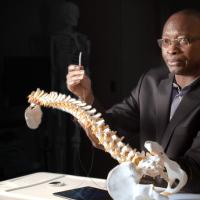The world of prosthetics is evolving quickly. It’s no question that researchers, doctors, and engineers want to design more effective robotic limbs that can help paralyzed and amputees live not only more comfortably, but more normal lives. The question is – how?
Prosthetics have come to life in a variety of ways, with recent evolvements looking more like a sci-fi depiction of the future. And most of this technology is designed to mimic our body and bring back the function that was lost.
But what if we went further? What if instead of relying on our body to control the technology, we decided to let the technology think for itself? That’s exactly what Dr. Tommaso Lenzi and his researchers at University of Utah’s Bionic Engineering Lab decided to bring to life. And their AI-powered bionic leg will change the future of advanced prosthetics.
Meet the Alec McMorris, the Emerging Cyborg
Today, Alec is a high school football coach, a patient advocate at Fit Prosthetics, and also the test subject for one of the most advanced robotic limbs on the planet. How did he get here?
In 2013, Alec was on his way to work on a cold Utah morning, when he saw his cousin crash his car ahead. Alec stopped to help, getting out of his car, and was struck by another out of control driver, moving at 85 MPH.
Alec was on life support for 5 days, suffering from severe internal and external injuries, a tear in his heart, and an infection in his leg. Alec’s right leg was eventually amputated. As Alec says, “I should have died. I should have died multiple times.” In a position that most would find completely debilitating, Alec found purpose.
“When you have been through something so traumatic and lost a limb – literally, a piece of you – then you know, I have to have some sort of purpose here.”
Alec McMorris
In this episode, our crew had the chance to see Alec in Dr. Lenzi’s lab, testing one of the world’s most advanced prosthetics in ways that have never been done before. Normally, Alec wears a passive prosthetic. But today, when he steps into Dr. Lenzi’s lab, he trades his conventional leg for an AI-powered bionic leg, with the goal of bringing new freedom to amputees.
Understanding the Limitations of Existing Prosthetic Legs
The most basic artificial limb is a passive prosthetic – one that is considered a cosmetic restoration, but provides no more than basic function back to its user. Think, a leg to support standing, or an arm to fill out normal clothing. Recently, powered prosthetics have become more used. They depend on the user to manually control, usually in the form of exaggerated body movements, and provide more function back to amputees.
Powered prosthetics are conventionally made to mimic their biological counterparts in terms of weight and power output. It seems fair – if someone has lost a limb, why not create an exact replica that the user can control? One of the main problems with this is that powered prosthetic devices don’t make much improvement on the functionality of passive prosthetic limbs. And in many cases, both passive and powered prosthetics actually slowed users down and caused physical strain to other parts of the body.
While on set with Alec, he explained some of the limitations trying to do something as seemingly simple as stepping over a small obstacle with his passive prosthetic leg. “If I’m going to step over (something) it’s a big swing over… or a step over and get high clearance on the back… Doing things like this, you know, that’s putting strain here, on my back, my hips, everything.”
What Sets This Bionic Leg Apart?
“The way we win at this game is by taking an approach that’s completely different from our biological leg… We decided to give a brain to the bionic leg.”
Dr. Tommaso Lenzi
Dr. Lenzi decided to challenge the conventional approach to prosthetics. To develop the robotic leg you see today, he made two major fundamental changes.
1 – Dr. Lenzi decided to create a powered prosthesis that is even lighter than a biological human leg. His leg is nearly half the weight of any comparable powered prosthesis.
2 – Where most prosthetics are controlled by the user – either manually or through sensory detecting nerve cuffs – Dr. Lenzi is letting the leg think for itself.
Essentially, Dr. Lenzi’s bionic leg is a lightweight, autonomous device that works symbiotically with its user by reading their normal body movements.
Sarah Hood, a Ph.D. Candidate at Utah’s Bionic Engineering Lab is working with Dr. Lenzi specifically on the interaction between the robot and humans.
“We’ve got an amputee coming in to walk on a robot. And that kind of sounds crazy when you put it in those words. Someone’s gonna come in and put their weight on it. And you have to believe 100% in the work that you’ve done.”
Sarah Hood Ph.D. Candidate
The Future for Advanced Prosthetics
Alec McMorris is more than a simple test subject of an engineering advancement. He’s seen as a collaborator for the University of Utah’s Bionic Engineering Lab, helping to define the path for the future of mobility. Alec says his job in this study is to give people hope. He goes on to say “‘Amplified humans’ is going to be a thing. And the fact that I get to see all of that before it happens, it’s magical.”
The future for Dr. Lenzi’s bionic leg is promising. Lighter and more powerful than a biological leg, this robotic option has the potential to provide its user with abilities potentially not available to the regular body. And it has all of asking, when can people get their hands on this leg?
“I believe that we are the generation that will see physical disability disappear.”
Dr. Tommaso Lenzi
For more inspirational stories about the amazing advances in medical innovation, check out our whole Superhuman Show now. For another Superhuman defying limits, meet Jason Barnes. Jason lost his arm in a horrible accident… and then he became the fastest drummer in the world. Watch more below:


